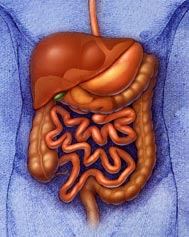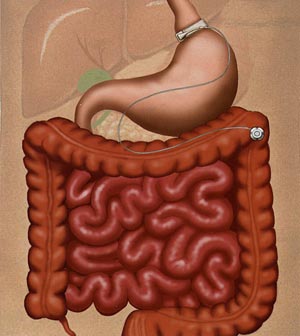
Informed Consent:
|
Lap Band System® Overview The Lap Band System® is actually the brand name of a specific FDA-approved, adjustable gastric band used in the generic procedure of gastric banding. This is a restrictive type of bariatric (weight loss) procedure, meaning that its physiological function is to limit your amount of caloric intake by causing you to feel full after consuming relatively small amounts of food. Unlike gastric bypass techniques, no part of the digestive system is bypassed, and unlike other restrictive procedures, there are no staples used nor are any parts of the digestive system removed. Although it has been restricted, the entire digestive system remains essentially intact, avoiding some of the post-surgical discomforts and relatively drastic long-term lifestyle alterations that other bariatric procedures require. The Anartomy of the Lap Band System® |
Advantage of Adjustability The gastric band is adjustable. The silicone band is filled with a sterile saline solution. A filler tube connects the band to a port that is typically placed discretely under the patient’s skin on the top part of the abdomen. The band can be filled with additional saline solution to increase its size and restrictive function, if necessary. Conversely, solution can be emptied from the system if a reduced effect is required. The adjustment procedures can typically be performed simply and quickly in the doctor’s office.
|
||
| Dr. Nowzaradan is a leader in the performance of surgical techniques laparoscopically. Today, surgeries of all types, not just bariatric, are performed using this less invasive technique. Dr. Nowzaradan has published numerous papers on laparoscopy. Prior to his accomplishments, many within the medical community thought his theories of laparoscopically performing various open procedures was impossible. Today, 15 years later, they are commonplace. | Laparoscopic Technique As with most weight loss surgeries, the Lap Band System® is typically performed laparoscopically. Instead of making long incisions and opening a patient, Dr. Nowzaradan makes a series of small incisions (about 1/2 inch to 1 inch in length) in the abdomen. At least one of these incisions is used to insert a temporary device, called a trocar, which allows Dr. Nowzaradan to introduce carbon dioxide gas into the abdomen, inflating it, thereby creating a larger workspace in the abdominal cavity. A tiny camera is inserted through one of the remaining small incisions. This sends a live, clear picture to a monitor in the operating room, that the doctor uses to guide delicate surgical instruments within the patient’s abdomen. These instruments are inserted through the final remaining incision(s). Once the placement of the band is complete, and the port in place, the excess abdominal gas is expelled, the trocars removed, and the incisions are closed. |
Advantage of Laparoscopic Technique Duration of Lap Band System® Proedure |
||
| Medical and Insurance Candidacy The Lap Band System® is generally considered a less expensive and less invasive form of weight loss surgery; however, it is also noted that weight loss with gastric banding is generally not as pronounced as with the Roux-en Y Gastric Bypass nor the Vertical Sleeve Gastrectomy. The medical candidacy requirements for a Lap Band System® are the same as those for any other bariatric procedure, although your specific insurance requirements may be easier to qualify for. After Surgery |
Frequent office visits to Dr. Nowzaradan are crucial after surgery, especially during the first 18 months. These are typically routine visits monitoring your weight loss, so that band adjustments, if any, can be made. As is the case with all surgeries, some complications can result. These can be detected early and resolved with minimal inconvenience with frequent follow-up office visits.
Post-surgical Complications |
|||



